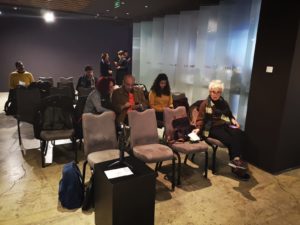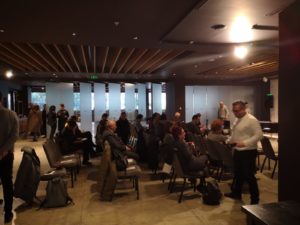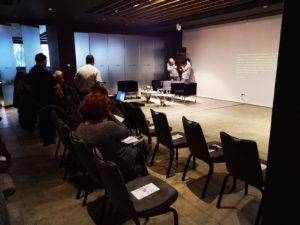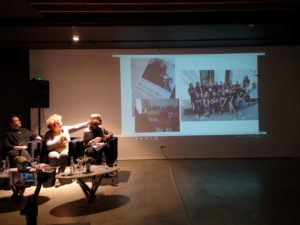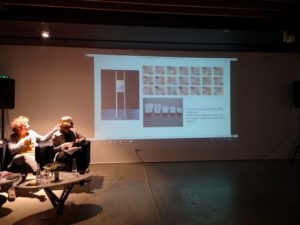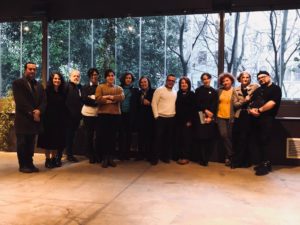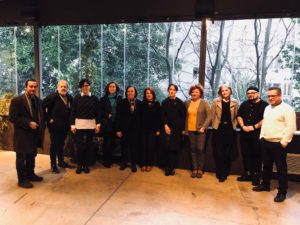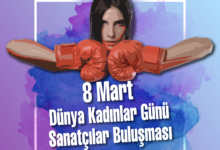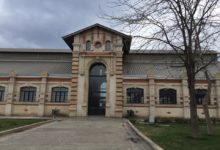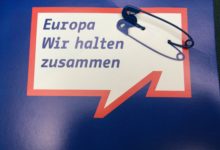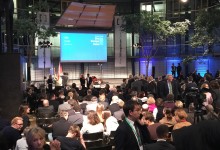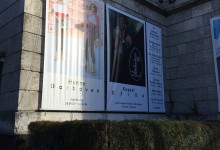50THAICA CONGRESS PRESENTATION
Everywhere and Nowhere : migration and contemporary art
The source of inspiration for this presentation is the philosopher, writer and journalist Villém Flusser, a refugee of WWII. His words about the concept of homeland/Heimat penetrate into the innermost core of the migrant and refugee tragedy that currently confronts humankind: “Homeland is not an eternal value but rather a function of a specific technology; still, whoever loses it suffers. This is because we are attached to Heimat by many bonds, most of which are hidden and not accessible to consciousness. Whenever these attachments tear or are torn asunder the individual experiences this painfully, almost as a surgical invasion of his most intimate person.” (1)
Homeland/Heimat/Patria concepts are bound to 20th century nationalism and racisms’ and their catastrophic, tragic and threatening consequences being witnessed by the humanity as constant global emigrations, refugees and exiles.
What does homeland mean today in active politics? Many political parties with rightist national ideologies name themselves “Homeland Party” which implicates a dedication and commitment to homeland, places it in sacredness and exempts it of any criticism. The concept is commonly used as a unique, unchangeable identity and source, and supposed to have mostly positive connotations. Home sounds like a harmless concept when used by right-wing extremists to convince the people that they have a moderate discourse. However, a Foucauldien interpretation claims the opposite: “The home supports the operations of modern regimes of power, bio-power, procedures and technologies of self, regulating and determining the habits of the body. Thus habituating the connections between the body and the nation, they function as regulatory controls: a bio-politics that results in excommunication from the home and homeland. Home and Homeland are interlinked; the home is intimately tied to what Foucault calls the games of truth, relations of power and forms of relations to oneself and to others.“(2)
The rights to live in a chosen country or the wish to live ruthlessly and the forced immigration or the refugee problem are two sides of these socio-political and economic arguments.
In both cases, immigration is elaborated by right wing politics as challenging and precarious to the concept of homeland/Heimat since the right to live ruthlessly as a world citizen or forced immigration opens up a flexibility, elimination and dispersal in the concept of homeland /Heimat. For right wing politics, this concept combines the basic assumptions of all radical and nationalist ideologies, according to which the individual is not free as a central, active subject, but submits to a supposedly closed, homogeneous community.
What is happening now on the shores and borders of Europe is almost prophesied in Foucault’s Madness and Civilisation:
“Confined on the ship, from which there is no escape, the madman is delivered to the river with its thousand arms, the sea with its thousand roads, to that great uncertainty external to everything. He is a prisoner in the midst of what is the freest, the openness of routes: bound fast at the infinite crossroads. He is the Passenger par excellence: that is, the prisoner of the passage. And the land he will come to is unknown—as is, once he disembarks, the land from which he comes. He has his truth and his homeland only in that fruitless expanse between two countries that cannot belong to him.” (3)
Now, witnessing the images of drifting and sinking boats in the Aegean and Mediterranean seas, we have to ask the question: What is the reason for today’s immigration, deportation and that via-politics?
From the mid 80s on, the outcome of the efforts of artists who have witnessed immigration or exile became visible and sustainable in Istanbul, Bagdad, Damascus, Beirut, Amman, Baku, Tbilisi, Yerevan, cities which embody the consequences of immigration or exile such as dystopia/heterotopia and neo-topia, all to be an extremely fertile field for artistic creativity. The artistic creativity of the migrant/exile has been observed by Vilem Flusser in his book, The Freedom of the Migrant. In fact he refers to the creativity of the migrant, rather than to his tragedy. He recognizes that the suffering is a part of the migration experience, but he argues that the creativity of the migrant is due to a dialogue that develops and that “consists of an exchange between the information that he brought with him and the ocean waves of information that wash him in exile.”
Are we able to accept the emigrants living in our cities or as our neighbors within Flusser’s concept? Do we accept their creative contribution to our culture?
Two of the answers to this question is “yes”; when we consider that modern and contemporary art is densely populated with artists who where immigrants, refugees, exiles and many artists are examining, questioning and criticizing the policies of immigration, the cruelty of border laws and the corruption of illegal human trafficking.
Apart from their surrealist and majestic presence, and their relational aesthetics, the works of many artists are a daring challenge to the ongoing human tragedy that involves almost all the countries around the Mediterranean. We all know that the seas of the Mediterranean are polluted with the shameful act of human trade, but we are powerless to prevent it. Artist step forward and performs a task, which not only brings the problem to the attention of the global media, the authorities and intellectuals but also relieves one’s mind in the sense that this tragedy is now decoded and exploited through art.
Contemporary art productions are a perfect opportunity for the humanity to face and challenge the global human movement with the universal language of contemporary art and thus have a civil commitment and positioning towards the ongoing tragedy. The art works try to raise questions about the sustainability of ideas of national and ethnic identity in a world whose borders are becoming increasingly accidental and penetrable. They try to open discussions on the traditional and post-modern societies which are now in flux, opposed by the global sweeping of networks and an excess of visual culture initiatives, despite their persistent traditional or modernist socio-political and economic infrastructures and epistemologies.
Flusser also argues that “We Need a Philosophy of Emigration”, which still is a very remote performance within the current cruelty of global politics. He indicates that modern societies are in flux, with traditional linear and literary epistemologies being challenged by global circulatory networks and a growth in visual stimulation. He says that these changes will radically alter the ways cultures define themselves and deal with each other. Not just theories of globalization, however, Flusser’s ideas about communication and identity have their roots in the concept of self-determination and self-realization through the recognition of the other.
Exile, Refugee, Immigration is a significant topic, discussion and theme of criticism in contemporary art as well as in documentary photography; so that we can examine:Artists who are immigrants and reflect their positions and experiences into their works; Artists who created works on these themes;Photographers who dedicated themselves to this human tragedy…
In each case there are crucial ethical questions, if the victims are photographed and their despair is openly displayed…
In avery timely essay“How not to photograph the Rohingya genocide in the making…”Suchita Vijayan discusses the negotiable ethics and manipulative character of images of massive forced migrations, massacres and other tragedies. (4) She asks crucial questions about all the images of victims and ill-fated people, which are all over in documentary and artistic photographs. Was there a consent? What do these images tell people, that they already do not know? What do they do with these images? Where should people go from here and what are the political possibilities of these images?
- Vilém Flusser,The Freedom of the Migrant: Objections to Nationalism, University of Illinois Press, 2003.
- Eric Harper and Charity Njoki Mwaniki, ‘Foucault: On Home and Homelessness’, http://www.academia.edu/10313350/Foucault_Home_and_Homeless_presentation_at_the_Critical_Space_Conference_London_. Accessed January 2016.
- Michel Foucault, Madness and Civilization: A History of Insanity in the Age of Reason, 1988, p. 11
4.http://www.suchitravijayan.com/archives/984
Collective, Collaborative and Creative Consciousness*
Conference Program with Contemporary Art Professionals from Neighbor Countries
16 – 17 January 2019, SOFA HOTEL, Istanbul, Turkey
REPORT
AICA Turkey invited curators and art critics from neigbor countries to Istanbul, to attend the conference entiteld “Collective, Collaborative and Creative Consciousness” that took place at Sofa Hotel, on 16 and 17 January 2019.
The aim and function of this conference in Istanbul, organized by AICA Turkey was to examine the state of networking, collaboration and exchange between the artists, art experts and art and culture institutions of neighbor countries and proposing new methods and actions to improve relationships and ensure the sustainability.
The participants were: Shulamit Bruckstein (Berlin, art critic and curator, www.taswir.org), Razvan Ion (Bucharest, www.bucharestbiennale.org), Syrago Tsara (Thessaloniki,), Irina Chemyeva (Moscow) and Rachel Sukman (TelAviv, President of AICA Israel). The two sessions of the forum was moderated by Beral Madra (Honorary president of AICA TR and Fırat Arapoğlu (President of AICA TR). Three invited participants Zoran Eric (Belgrade, Museum of Contemporary Art), Iara Boubnova(Sofia, National Gallery for Foreign Art), Isaa Touma (Aleppo, Photographer and curator) could not come due to private political and ecomnomic reasons.
The title of this conference is quite common. The contemporary art world is actually based on these concepts “Collective, Collaborative and Creative Consciousness”. Without these we will not be able to continue with our professions. Why we decided to organize this conference is also very understandable.
In the age of Post-truth, when political and economic hardships are disturbing the state of affairs in our professional field, we wanted to examine the state of networking, collaboration and exchange between the artists, art experts and art and culture institutions of neighbor countries and looking for possibilities of new methods and actions to improve relationships and ensure the sustainability.
We are aware that current local wars and economic shortfalls in the region remain obstacles to the continuation of cultural and artistic exchange. Under the circumstances artists and experts in the region are dependent on the art market in Western EU countries rather than in their own countries.
Considering the geo-political and economic turmoil in the region and the neo-liberalist positioning of the official cultural policy of the governments, we think that we should re-question the function, success and influence of contemporary art productions and activities and art- and culture-criticism in our countries as well as the germinal possibilities of working in partnerships, collective and collaborative methods for the benefit of artists and art experts.
Within this framework we asked the following questions to the participants:
Have you lately been in meetings where everyone is playing nice, but nothing is accomplished? Why? Conversely, have you left a meeting feeling satisfied and highly productive? Why? Have you lately experienced collaboration and collective impact? How? Collaborative and Collective Impact is not easy to achieve within the political and economic state of affairs in our region; how can we achieve solid results if we try to continue collaborative and collective initiatives? What are the current essential problems in the development of collective projects? Can we overcome bureaucratic and financial discrepancies? How? Can we set aside our ego, agendas, and turf to work together for the greater good and make things happen? If we truly want to change something, especially anything complex in our profession, how can we proceed?
We can summerise the responses as follows:
-Communication and collaboration with the artists and colleagues of neighboring countries are mainly based on individual initiatives and networking, rather than on a strong system of artistic and theoretical exchange or a sustainable official or private sector culture and art policy.
-Recent activities (2018) in the region were: 5th Thessaloniki Biennale, 8th Bucharest Biennale. Artists and curators from the neighbor countries were invited to these two biennale; however communication and collaboration with Russia and Israel was quite insufficient.
-Berlin-Istanbul collaboration is quite active due to DAAD and Berlin Senate scholarships; however there is no significant contribution to this sustainable collaboration from the side of Turkey’s official or private sector culture and art system.
-The civil art and culture NGO’s are dependend on member fees and have no official support and little private sector support.
-Solid results can only be achieved if all the NGO’s of the region can launch a new effective culture and art policy system demand to their states and governments. The governments and political parties should be made aware of the influence of art and culture projects over democratisation processes that urgently needed in the region.
– Through this timely conference, despite political and economic difficulties, the experts and artists of neigboring countries should continue to realize effective and productive activities and inform their governments and major art and culture institutions and offices in EU.
– Discussing the positive and negative issues that effect the production and activities in the art scenes is a way to transfer new knowledge and hope to young generations and to the public.
We are informing AICA International headquartes with the hope that our voice will be heard and necessary systems and protections will be promoted and realized.
We hope that the outcome of this conference will be included and adopted for the near future policies of all responsible parties.

